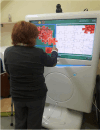The role of virtual reality-based cognitive training in enhancing motivation and cognitive functions in individuals with chronic stroke
- PMID: 40652006
- PMCID: PMC12255692
- DOI: 10.1038/s41598-025-08173-1
The role of virtual reality-based cognitive training in enhancing motivation and cognitive functions in individuals with chronic stroke
Abstract
Stroke represents a major health challenge worldwide, often resulting in significant long-term disability that affects cognitive, motor, and emotional functions. Rehabilitation strategies that enhance patient motivation are crucial for improving outcomes. This randomized controlled trial investigated the impact of Virtual Reality Rehabilitation Systems (VRRS) compared to traditional cognitive training on motivation, cognitive recovery, and emotional state in post-stroke patients. Fifty-four adults with chronic stroke were randomized into two equal groups (27 participants per group). The experimental group received 24 sessions of Virtual Reality (VR) cognitive training, while the control group underwent 24 sessions of traditional cognitive rehabilitation. Motivation was assessed using the McClelland test, while cognitive and emotional states were evaluated using the Montreal Cognitive Assessment (MoCA) and Hamilton Rating Scales for Anxiety and Depression (HAM-A, HAM-D). The experimental group exhibited significant improvements in motivation, with marked increases in Achievement (T0: 68.41 ± 15.81, T1: 68.93 ± 15.80; p < 0.001) and Affiliation(T0: 60.67 ± 14.64, T1: 60.93 ± 15.59; p = 0.006) dimensions, alongside enhanced cognitive function (T0: 24.781 ± 1.89, T1: 26 (24.5-27); p = 0.001), reduced depressive (T0: 41 ± 2.32, T1: 6 (4-8); p = 0.003) and anxiety symptoms (T0: 4.26 ± 1.99, T1: 3.30 ± 1.94; p < 0.001). The Control Group showed significant differences only in MOCA (T0: 25 (23-26.5), T1: 25 (24-27); p < 0.001). Between-group analysis revealed no significant differences between the two groups. These findings underscore the potential of VR as a multifaceted tool to boost motivation, facilitate cognitive recovery, and improve emotional state, offering a comprehensive approach to post-stroke rehabilitation.
© 2025. The Author(s).
Conflict of interest statement
Declarations. Competing interests: The authors declare no competing interests.
Figures





Similar articles
-
The Effectiveness of Therapeutic Exercise Interventions With Virtual Reality on Balance and Walking Among Persons With Chronic Stroke: Systematic Review, Meta-Analysis, and Meta-Regression of Randomized Controlled Trials.J Med Internet Res. 2024 Dec 2;26:e59136. doi: 10.2196/59136. J Med Internet Res. 2024. PMID: 39621381 Free PMC article.
-
Randomised control trial of virtual reality in cognitive rehabilitation: effectiveness and near-transfer effect for stroke patients.BMC Psychol. 2025 Jul 18;13(1):805. doi: 10.1186/s40359-025-03135-8. BMC Psychol. 2025. PMID: 40682194 Free PMC article. Clinical Trial.
-
The Potential Effects of Sensor-Based Virtual Reality Telerehabilitation on Lower Limb Function in Patients with Chronic Stroke Facing the COVID-19 Pandemic: A Retrospective Case-Control Study.Med Sci (Basel). 2025 May 23;13(2):65. doi: 10.3390/medsci13020065. Med Sci (Basel). 2025. PMID: 40559223 Free PMC article.
-
Effectiveness of Using Virtual Reality-Supported Exercise Therapy for Upper Extremity Motor Rehabilitation in Patients With Stroke: Systematic Review and Meta-analysis of Randomized Controlled Trials.J Med Internet Res. 2022 Jun 20;24(6):e24111. doi: 10.2196/24111. J Med Internet Res. 2022. PMID: 35723907 Free PMC article.
-
Impact of Virtual Reality-Based Biofeedback on Sleep Quality Among Individuals With Depressive Symptoms, Anxiety Symptoms, or Both: 4-Week Randomized Controlled Study.J Med Internet Res. 2025 Jun 20;27:e65772. doi: 10.2196/65772. J Med Internet Res. 2025. PMID: 40539943 Free PMC article. Clinical Trial.
References
-
- World Health Organization (WHO). https://www.who.int.
-
- Home page. https://www.istat.it/en/.
-
- Langhorne, P., Legg, L., Pollock, A. & Sellars, C. Evidence-based stroke rehabilitation. Age Ageing31(Suppl 3), 17–20 (2002). - PubMed
Publication types
MeSH terms
Grants and funding
- 2024/This study was supported by Current Research Funds 2024, Ministry of Health, Italy.
- 2024/This study was supported by Current Research Funds 2024, Ministry of Health, Italy.
- 2024/This study was supported by Current Research Funds 2024, Ministry of Health, Italy.
- 2024/This study was supported by Current Research Funds 2024, Ministry of Health, Italy.
- 2024/This study was supported by Current Research Funds 2024, Ministry of Health, Italy.
LinkOut - more resources
Full Text Sources
Medical

